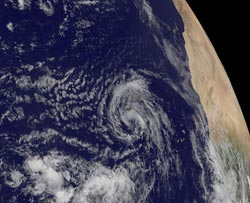Erin Weakens to a Tropical Depression Over Eastern Atlantic

NOAA's GOES-East satellite captured this visible image of Tropical Depression Erin on Aug. 16 at 1445 UTC/10:45 a.m. EDT. <br>Image Credit: NASA GOES Project<br>
NOAA's GOES-East satellite captured a visible image of Tropical Depression Erin on Aug. 16 at 1445 UTC/10:45 a.m. EDT. The image was created by NASA's GOES Project at NASA Goddard Space Flight Center in Greenbelt, Md. and showed that the storm still had good circulation, but the clouds and showers had diminished.
The National Hurricane Center noted that Erin's structure consists of a low-level cloud swirl with a couple of small areas of convection south and east of the center.
At 11 a.m. EDT/1500 UTC, Erin's maximum sustained winds dropped to near 35 mph/55 kph. NOAA's National Hurricane Center expects little change in strength over the next couple of days.
The center of Tropical Depression Erin was located near latitude 16.9 north and longitude 32.1 west, about 540 miles/870 km west of the Cape Verde Islands. The estimated minimum central pressure is 1008 millibars.
The depression is moving toward the west-northwest near 17 mph/28 kph. Erin is expected to continue in that general direction and slow down in a couple of days while maintaining strength.
Text credit: Rob Gutro
NASA's Goddard Space Flight Center
Media Contact
All latest news from the category: Earth Sciences
Earth Sciences (also referred to as Geosciences), which deals with basic issues surrounding our planet, plays a vital role in the area of energy and raw materials supply.
Earth Sciences comprises subjects such as geology, geography, geological informatics, paleontology, mineralogy, petrography, crystallography, geophysics, geodesy, glaciology, cartography, photogrammetry, meteorology and seismology, early-warning systems, earthquake research and polar research.
Newest articles

Microscopic basis of a new form of quantum magnetism
Not all magnets are the same. When we think of magnetism, we often think of magnets that stick to a refrigerator’s door. For these types of magnets, the electronic interactions…

An epigenome editing toolkit to dissect the mechanisms of gene regulation
A study from the Hackett group at EMBL Rome led to the development of a powerful epigenetic editing technology, which unlocks the ability to precisely program chromatin modifications. Understanding how…

NASA selects UF mission to better track the Earth’s water and ice
NASA has selected a team of University of Florida aerospace engineers to pursue a groundbreaking $12 million mission aimed at improving the way we track changes in Earth’s structures, such…





















